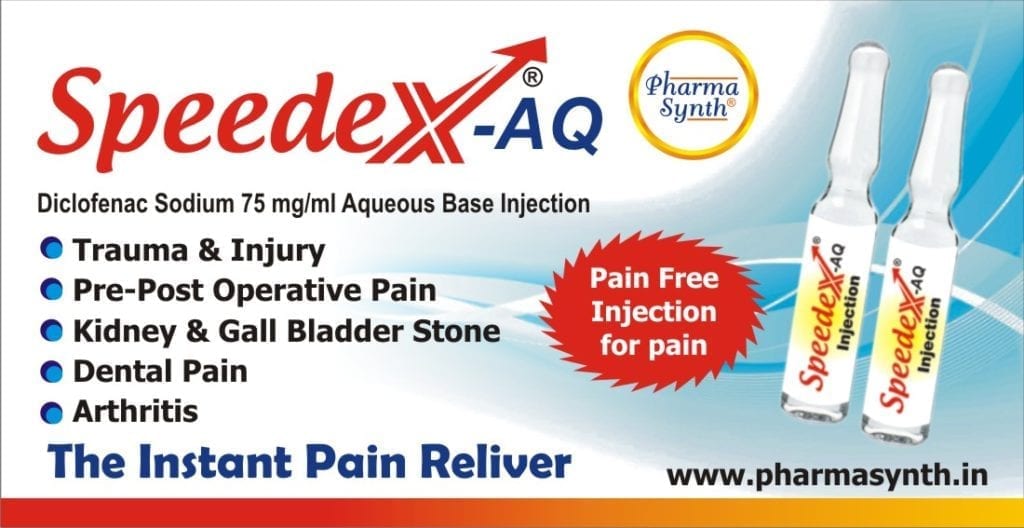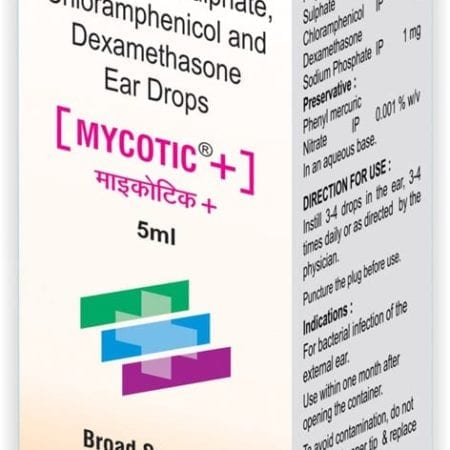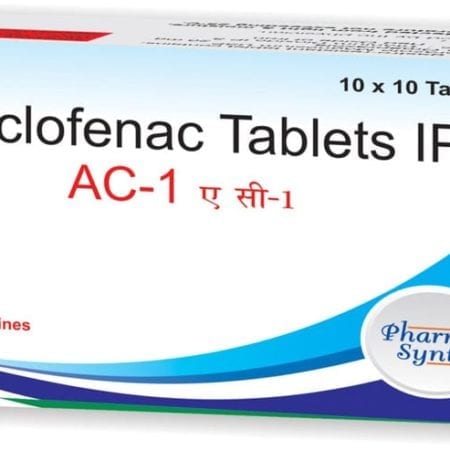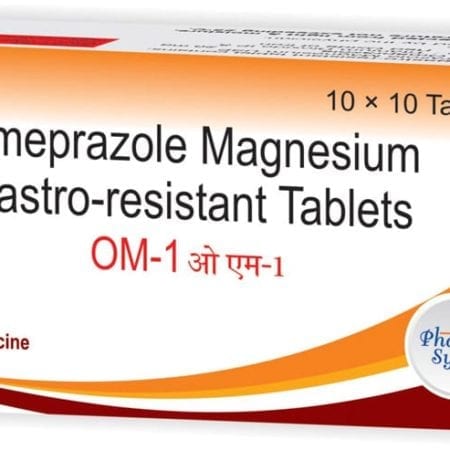Speedex-AQ Inj.
Description

Composition:
Each ml contains
Diclofenac sodium IP 75mg
Dosage form:
Solution for Injection
ATC classification:
Analgesic and anti inflammatory
Description:
Speedex-AQ injection is a diclofenac sodium injection in an aqueous base that is well tolerated and with lower incidences of thrombophelebitis whilst compared to conventional parenteral formulation of diclofenac sodium in oil base (developed with polyethylene glycol and benzyl alcohol [PG-BA] as excipients). Speedex-AQ diclofenac sodium injection has been formulated using hydroxypropyl beta-cyclodextrin as a solubility enhancer (HPbetaCD diclofenac). It is suitable for intravenous bolus injection and is bioequivalent to PG-BA diclofenac, which requires slow intravenous infusion over 30 minutes. It also shows faster onset of analgesia and for equal duration in the treatment of moderate or severe postoperative dental pain compared to PG-BA diclofenac. Speedex-AQ injection offers an added advantage of intra deltoid and intra gluteal administration. It delivers full dose of 75mg in just 1 ml with less pain at the site of injection which makes it more patient compliant as smaller volumes of concentrated solution cause much less muscle damage compared to larger volumes of relatively less concentrated solutions.
Pharmacological action:
Diclofenac works by inhibiting the enzyme, cyclooxygenase (COX), an early component of the arachidonic acid cascade that results in the formation of prostaglandins, thromboxanes and prostacyclin. Prostaglandins are produced at sites of injury or damage causing pain and inflammation. Diclofenac by blocking the effect of COX enzymes, reduce the prostaglandin formation, which means pain and inflammation are eased.
Pharmacodynamic effects:
Diclofenac sodium elicits a clinical response characterized by marked relief from signs and symptoms such as pain at rest, pain on movement, morning stiffness, and swelling of the joints and pain, edema, swelling associated with post-traumatic and post-operative inflammatory conditions. It shows analgesic effect within 15 to 30 minutes in cases of moderate and severe pain of non-rheumatic origin. When diclofenac is used concomitantly with opioids for the management of post-operative pain, it significantly reduces the need for opioids.
Pharmacokinetics of diclofenac:
Following intravenous administration of diclofenac aqueous base injection to healthy volunteers, plasma concentrations of diclofenac after 5 minutes of administration were found to exceed by 4.8 times to that of immediate-release oral diclofenac for the first 45 minutes.
Distribution:
Diclofenac is more than 99% bound to human serum albumin. It diffuses into and out of the synovial fluid. Diffusion into the joints is driven by drug concentration gradient between plasma and synovial fluid. When plasma levels are higher than those in the synovial fluid, drug diffuses into the joints and after which the process reverses and synovial fluid levels are higher than plasma levels. Thereby therapeutic concentrations of drug are achieved into the synovial fluid.
Metabolism:
Five metabolites of diclofenac have been identified in human plasma and urine. The major diclofenac metabolite, 4’-hydroxy-diclofenac, has very weak pharmacologic activity.
Excretion:
The glucuronide and the sulfate conjugate of the metabolites of diclofenac are eliminated through urinary and biliary excretion. Plasma elimination of drug follows biexponential equation with a terminal phase half-life of approximately 1.4 hours following intravenous administration. Urinary excretion accounts for 65% of the administered dose whereas biliary excretion eliminates 35% of the dose.
Indications:
Speedex-AQ injection is indicated for management of moderate to severe pain alone or in combination with opioid analgesics.
Intramuscular use:
• acute forms of pain, including renal colic
• exacerbations of osteoarthritis and rheumatoid arthritis
• acute back pain
• acute gout,
• acute trauma and fractures and
• post-operative pain
Intravenous use:
• For treatment or prevention of post-operative pain in supervised health care settings.
• As preemptive analgesic in reducing postoperative pain and distress associated with painful dental procedures.
Dosage and Administration:
Adults: Speedex-AQ Injection should not be given for more than two days.
Dose for Renal colic: One 75 mg dose intramuscularly. A further dose may be administered after 30 minutes if necessary. The recommended maximum daily dose is 150 mg.
Intramuscular injection:
• One vial daily, intramuscularly by deep intragluteal injection into the upper outer quadrant of the buttock. In severe cases if two injections daily are required, it is advised that the alternative buttock be used for the second injection.
Method of administration:
• To ensure deep intramuscular injection, give high into upper outer quadrant of the buttock, taking particular care to avoid the sciatic nerve, blood vessels and area where resistance is felt.
• In obese patients care should be taken to avoid deposition of drug in subcutaneous fatty tissue.
• In small thin patients with little muscle bulk care should be taken to avoid injecting into sciatic nerve which may be quite superficial.
• Prior to injection of solution via IM route, drawback to ensure that no blood vessel has been penetrated. If blood is drawn, withdraw the needle to another site and check again.
Intravenous use:
• For the treatment of postoperative pain a dose of Speedex- AQ 75 mg injection may be given over 30 to 120 minutes as IV infusion or as a bolus injection
• For post operative pain the initial dose may be given as a bolus injection over 5 to 60 seconds followed by additional injections up to the maximum daily dosage; this may be repeated after 4 to 6 hours if necessary.
Note: The total dose should not exceed the maximum daily dose of 150 mg
Contraindications:
Speedex-AQ injection is contraindicated in:
¬ Patients with hypersensitivity or idiosyncrasy to any of its ingredients and NSAIDs and aspirin.
¬ In patients with active gastric or intestinal ulcer GI bleeding, perforation, moderate to severe renal impairment and acute porphyria
¬ Diclofenac containing formulations should only be initiated after careful consideration for patients with significant risk factors for cardiovascular events (eg, hypertension, hyperlipidaemia, diabetes mellitus, and smoking).
¬ Patients in whom aspirin or other NSAIDs, precipitate attacks of bronchospasm, urticaria or acute rhinitis.
¬ Patients with severe heart failure, hypertension, hepatic or renal insufficiency.
¬ Last trimester of pregnancy and also in children.
Side effects:
Common: Headache, dizziness, nausea, vomiting, diarrhoea, dyspepsia, abdominal pain, flatulence, anorexia, injection site reaction, injection site pain, injection site induration
Discontinue use if any hypersensitivity reactions
Warnings and Precautions:
Cardiovascular Risk:
¬ Non-steroidal anti-inflammatory drugs (NSAIDs) may increase the risk of serious cardiovascular (CV) thrombotic events, myocardial infarction, and stroke, which can be fatal.
¬ Risk may increase with duration of use.
¬ Use with caution in patients with fluid retention or congestive heart failure or any other cardiovascular disease or who are at risk factors for cardiovascular disease.
¬ Monitor blood pressure closely during treatment with Speedex-AQ injection
¬ Speedex-AQ injection is contraindicated for the treatment of perioperative pain in the setting of coronary artery bypass graft (CABG) surgery.
Gastrointestinal Risk:
¬ NSAIDs increase the risk of serious gastrointestinal (GI) adverse events including bleeding, ulceration, and perforation of the stomach or intestines, which can be fatal.
Note: Events can occur at any time without warning symptoms. Elderly patients are at greater risk
¬ Precaution to be exercised in patients with: Gastrointestinal bleeding, history of peptic ulceration, cerebrovascular bleeding, ulcerative colitis, Crohn’s disease, systematic lupus erythromatosus (SLE), porphyria, hematopoietic or coagulation disorders, Raynaud’s phenomenon.
¬ Discontinue Speedex-AQ immediately if abnormal liver tests persist or worsen.
¬ Discontinue Speedex-AQ injection immediately if an anaphylactic reaction occurs
Drug Interactions:
¬ Diclofenac may increase the plasma concentrations of lithium & digoxin.
¬ Concomitant use of diclofenac & diuretics may inhibit the activity of diuretics
¬ The activity of anticoagulants may be enhanced when used concomitantly with diclofenac.
¬ It may increase toxicity of drugs like cyclosporine.
¬ NSAIDs may diminish anti-hypertensive action of ACE-inhibitors.
¬ Concomitant use of diclofenac and aspirin is not generally recommended because of the potential risk of adverse effects including increased GI bleeding.
Pregnancy and Lactation:
Avoid use after 30 weeks gestation because premature closure of the ductus arteriosus in the fetus may occur.
Use with caution in lactating mothers as diclofenac may be present in human milk.
References:
Diclofenac- https://pubchem.ncbi.nlm.nih.gov/compound/diclofenac#section=Drug-and-Medication-Information
Diclofenac sodium injection in postoperative pain:
https://www.ncbi.nlm.nih.gov/pubmed/18081376
Dynapar aq IV bolus injection for postoperative pain:
https://www.fda.gov/
Disclaimer:
Information provided above is for reference purpose only and has been compiled for use by healthcare practitioners. Please consult your physician to understand how the product affects you, its dosages, side-effects and further information.
Remember, keep this and all other medicines out of the reach of children, never share your medicines with others, and use this medication only for the indications prescribed by your physician.
Every effort has been made to ensure that the information provided by Pharma Synth Formulations Ltd. (‘PSFL’) is accurate, up-to-date, and complete, but no guarantee is made to that effect. PSFL does not endorse drugs, diagnose patients or recommend therapy and is an informational resource designed to assist licensed healthcare practitioners in caring for their patients and/or to serve consumers viewing this service as a supplement to, and not a substitute for, the expertise, skill, knowledge and judgment of healthcare practitioners. PSFL does not assume any responsibility for any aspect of healthcare administered with the aid of information provided. The information contained herein is not intended to cover all possible uses, directions, precautions, warnings, drug interactions, allergic reactions, or adverse effects. If you have questions about the drugs you are taking, check with your doctor, nurse or pharmacist.




